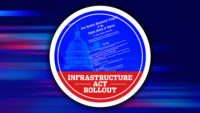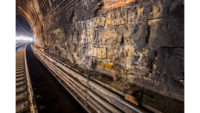The U.S. Dept. of Transportation is working with Amtrak on a plan to repair and rehabilitate the 110-year-old tunnel under the Hudson River while keeping the tube open to rail traffic, Transportation Secretary Elaine Chao says.
But a key House leader opposes the upgrade plan unless DOT also clears funding for a proposed $12-billion new Hudson tunnel.
Chao disclosed the development on Feb. 27, during testimony before the House transportation appropriations subcommittee. She said, “Given the time, the cost and the complexity of building an entirely new tunnel, the department is working with Amtrak to design and validate a faster and more cost-effective method to improve safety and functionality of this tunnel as the first order of business.” [View video of House subcommittee hearing here.]
She said, "Beginning rehab work in the near term is the right move, and not waiting years for the construction of a new tunnel beforehand." The tunnel was damaged by Superstorm Sandy in 2012.
Chao added, "New and innovative methods for repairing the North River Tunnel—the Hudson Tunnel—while still in operation could allow Amtrak to commence repairs on this tunnel as much as 10 years ahead of schedule."
But Rep. Nita Lowey (D-N.Y.), who chairs the full Appropriations Committee, called the plan “a nonstarter,” unless DOT also approves the New York-New Jersey proposal to build a new tunnel under the Hudson.
Lowey said at the hearing that one problem with a tunnel rehab is that it wouldn’t increase rail capacity. The new-tunnel project would add two tracks to the two that are there now.
She said, “Without a new tunnel and two new tracks…the bottlenecks will continue to limit Amtrak and commuter rail, which limits economic growth throughout the Northeast.”
Lowey added, “Just rehabilitating the current tunnel is a nonstarter.”
Chao said, "What we are suggesting at the department is: Can we not do this concurrently, take a look at the existing tunnel, repair that, while we are preparing for the second tunnel." That new project would take seven to 10 years, she said.
The Federal Transit Administration’s latest overall rating, released on Feb. 10, for the new Hudson tunnel for a Capital Investment Grant, is “medium-low," which isn't high enough to qualify for the funds. [View FTA's ratings of the new tunnel and other applicants for the capital grants here.]
The project does have a project-justification rating of “high,” but its overall score is dragged down by a “low” rating for financial commitment.
She noted that New Jersey was able to get the rating for Amtrak's planned replacement for the aging Portal Bridge near Newark to qualify for a FTA capital grant. [View ENR 2/10/2020 story on DOT and the Portal Bridge here.]
Chao, noting the state's rivalry with New Jersey, added, "I'm sure New York is not very happy about [the upgrade for the Portal Bridge rating]." She said, "But they've got to get their rating up to at least a medium-high for us to be able to talk about financing."
Chao didn’t say what the cost of the possible short-term rehab of the current tunnel would be, when it would begin or how long the work would take.
The secretary did say that DOT “took a page” from a New York City subway project backed by New York Gov. Andrew Cuomo (D). In late 2018, he was apparently unhappy with a plan to close the L train’s Canarsie Tunnel for perhaps 15 months while its interior was demolished and rebuilt. [View ENR 1/16/2019 story on the Canarsie Tunnel plans here.]
Cuomo contacted engineering school deans, and other faculty members, at Cornell and Columbia universities, who advocated a “racking” system for interior cables, which avoided having to tear out and replace the walls.
Chao said, “We want to piggyback on [the academics' and Cuomo's] idea, get those experts to come and look at the Hudson Tunnel, to see how we could in the interim repair it, because safety…is a major issue.”
Amtrak said in an emailed statement, “We have been in constructive discussions with DOT about ways Amtrak is seeking to advance some elements of tunnel rehab prior to the construction of a new Hudson River Tunnel, given current conditions and the need to ensure reliability."
The statement continued, "A new Hudson Tunnel remains critical to the Northeast Corridor and the nation and we look forward to our continued work with US DOT to advance this project.”
DOT didn’t respond on Feb. 27 to ENR’s request for further details about the tunnel upgrade plan.




Post a comment to this article
Report Abusive Comment